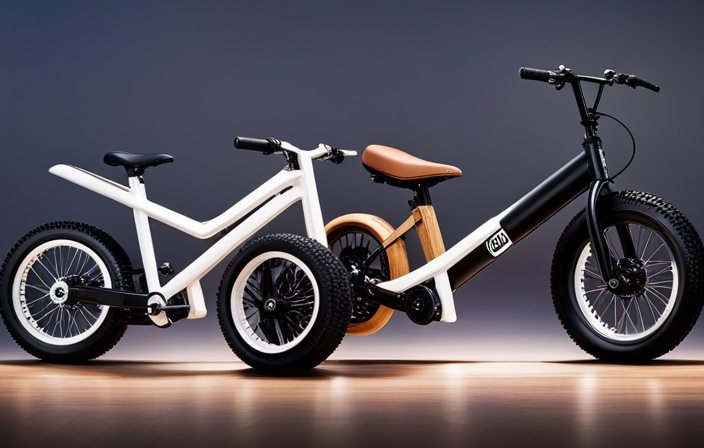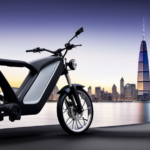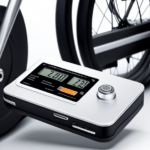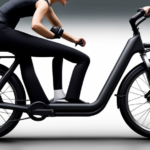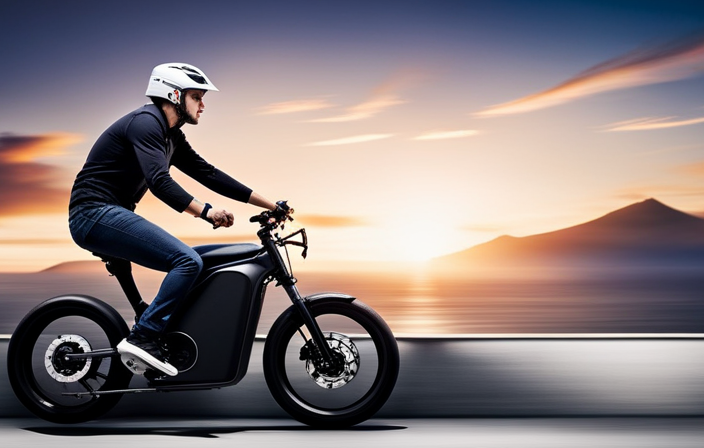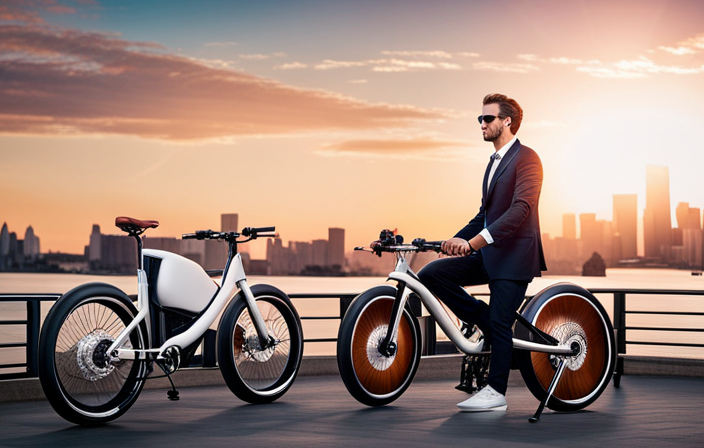As a passionate electric bike aficionado, I have been consistently searching for the top-performing battery to fuel my journeys.
In this article, we’ll delve into the world of electric bike batteries, exploring the pros and cons of various types, including lithium-ion, lead-acid, nickel-metal hydride, lithium iron phosphate, and nickel-cadmium.
We’ll also discuss essential tips for battery maintenance and care, as well as the importance of recycling and proper disposal.
So strap in and let’s find the perfect battery for your electric bike!
Key Takeaways
- Lithium-ion batteries have high energy density for longer rides
- LiFePO4 batteries have high energy density and long cycle life
- NiCd batteries have long cycle life and resistance to overcharging
- NiMH batteries offer improved energy density and longer lifespan
Lithium-Ion Batteries
If you’re looking for the best battery for your electric bike, you should consider using lithium-ion batteries. When it comes to battery performance, lithium-ion batteries are among the top choices for electric bikes. They have a high energy density, which means they can store a large amount of energy in a compact and lightweight package. This allows you to go further on a single charge and reduces the overall weight of your bike.
In addition to their impressive energy density, lithium-ion batteries also have a relatively short charging time. This means you can spend less time waiting for your battery to charge and more time riding your electric bike. The charging time of lithium-ion batteries can vary depending on the specific battery and charger you use, but in general, they can be fully charged in a matter of hours. This is much faster compared to other types of batteries, such as lead-acid batteries, which can take much longer to charge.
Speaking of lead-acid batteries, they are another popular choice for electric bikes, but they have some drawbacks compared to lithium-ion batteries.
Lead-Acid Batteries
Lead-Acid batteries are not as commonly used for electric bikes due to their heavy weight and shorter lifespan. When it comes to battery charging techniques, Lead-Acid batteries require a specific charging process that involves carefully monitoring the voltage and current levels to prevent overcharging or undercharging. This is crucial for maximizing the battery’s lifespan and performance. Additionally, the lifespan of a Lead-Acid battery is influenced by several factors. The frequency of charging cycles, the depth of discharge, and the ambient temperature all play a role in determining how long the battery will last.
Transitioning to the subsequent section about Nickel-Metal Hydride (NiMH) batteries, these batteries have gained popularity in the electric bike industry for their improved energy density and longer lifespan compared to Lead-Acid batteries. NiMH batteries also have a higher charge retention rate, which means they can hold their charge for longer periods of time when not in use. This makes them a more reliable choice for electric bike riders who may not use their bikes on a daily basis. Furthermore, NiMH batteries are lighter than Lead-Acid batteries, making them a more practical option for electric bike manufacturers and riders alike.
Nickel-Metal Hydride (NiMH) Batteries
When it comes to choosing a battery for your electric bike, you’ll be pleased to know that Nickel-Metal Hydride (NiMH) batteries offer improved energy density and a longer lifespan compared to other options. Here are four reasons why NiMH batteries are a great choice for your electric bike:
-
Enhanced Battery Performance: NiMH batteries have a higher energy density, allowing them to store more power and deliver longer rides on a single charge. This means you can enjoy extended cycling sessions without worrying about running out of battery.
-
Reliable Charging Time: NiMH batteries have a shorter charging time compared to other battery types. With their efficient charging capabilities, you can quickly recharge your electric bike and get back on the road in no time.
-
Extended Lifespan: NiMH batteries have a longer lifespan than their counterparts. This means you can expect your battery to last for several years, providing consistent performance and value for your investment.
-
Environmentally Friendly: NiMH batteries are more eco-friendly compared to other battery options. They contain fewer toxic materials, making them easier to recycle and reducing their impact on the environment.
Now, let’s move on to the next section about lithium iron phosphate (LiFePO4) batteries, which offer even greater benefits for electric bike riders.
Lithium Iron Phosphate (LiFePO4) Batteries
Now, let’s explore why lithium iron phosphate (LiFePO4) batteries are a fantastic option for your electric bike.
LiFePO4 batteries have several factors that contribute to their excellent performance. First and foremost, they have a high energy density, meaning they can store a large amount of energy in a compact size. This is crucial for electric bikes, as it allows for longer rides without the need for frequent recharging.
Another important factor is their long cycle life. LiFePO4 batteries can withstand a large number of charge and discharge cycles, making them durable and reliable. This is especially beneficial for electric bike owners who use their bikes frequently, as the battery will last longer before needing to be replaced.
Furthermore, LiFePO4 batteries have a high level of thermal stability. This means they are less likely to overheat compared to other types of lithium batteries, reducing the risk of damage or even fire. Safety is paramount when it comes to batteries, and LiFePO4 batteries prioritize it.
When comparing LiFePO4 batteries to other types of lithium batteries, such as lithium-ion or lithium polymer, LiFePO4 batteries have a lower energy density. However, they make up for it with their superior safety and longevity. The choice ultimately depends on the individual’s priorities and requirements.
Transitioning to the subsequent section about nickel-cadmium (NiCd) batteries, it is important to consider their own set of advantages and disadvantages.
Nickel-Cadmium (NiCd) Batteries
If you’re looking for a reliable and durable option, nickel-cadmium (NiCd) batteries are worth considering due to their long cycle life and resistance to overcharging. These batteries have several advantages over other types when it comes to battery lifespan, charging time, and efficiency.
Here are four reasons why NiCd batteries might be the best choice for your electric bike:
-
Long Cycle Life: NiCd batteries can withstand hundreds of charge-discharge cycles without significant degradation in performance. This means they can last for a long time, providing reliable power for your electric bike.
-
Resistance to Overcharging: NiCd batteries are less prone to overcharging compared to other battery types. Overcharging can lead to reduced battery lifespan and even safety hazards. With NiCd batteries, you can be confident that your battery will be protected from overcharging.
-
Fast Charging: NiCd batteries have the advantage of fast charging capabilities. They can be charged at higher currents, reducing the overall charging time. This means less waiting time and more time on the road.
-
High Efficiency: NiCd batteries have a high energy efficiency, allowing them to deliver more power for a longer period. This efficiency translates into a longer range for your electric bike and a better overall riding experience.
Transitioning into the subsequent section about lithium polymer (lipo) batteries, it’s important to explore other options and compare their features to make an informed decision.
Lithium Polymer (LiPo) Batteries
To get the most out of your lithium polymer (LiPo) battery, it’s important to properly balance and monitor its cells. LiPo batteries have become increasingly popular due to their high energy density and lightweight nature, making them ideal for a wide range of applications, including electric bikes. However, it’s crucial to prioritize safety when using LiPo batteries.
When it comes to LiPo battery safety, there are a few key tips to keep in mind. First and foremost, always use a charger specifically designed for LiPo batteries. This will ensure that the battery is charged at the correct voltage and current levels, preventing overcharging or undercharging. Additionally, never leave a charging LiPo battery unattended and always charge it in a fireproof container or on a fireproof surface to minimize the risk of fire.
Properly monitoring the cells of your LiPo battery is also essential for its longevity. Regularly check the voltage of each cell using a LiPo cell checker or a multimeter. If any cell’s voltage deviates significantly from the others, it may indicate an imbalance and should be addressed immediately. Balancing the cells can be done using a LiPo balance charger or a balance board.
By following these LiPo battery charging tips and prioritizing safety, you can ensure that your LiPo battery remains in optimal condition for maximum performance and lifespan.
As we move forward in exploring different battery options for electric bikes, let’s now delve into the world of sodium-ion batteries.
Sodium-Ion Batteries
Moving on from Lithium Polymer (LiPo) batteries, let’s now delve into the world of sodium-ion batteries. Sodium-ion battery technology has gained significant attention in recent years as a potential alternative to lithium-ion batteries. These batteries use sodium ions instead of lithium ions to store and release electrical energy.
One of the main advantages of sodium-ion batteries is the abundance of sodium, making it a more sustainable and cost-effective option compared to lithium. Additionally, sodium-ion batteries have shown promising energy storage capabilities, with some prototypes achieving comparable energy densities to lithium-ion batteries.
However, sodium-ion battery technology is still in its early stages of development, and there are several challenges that need to be addressed before it can become a viable commercial option. These challenges include improving the overall energy density, enhancing the cycle life, and addressing the issues related to the larger size and weight of sodium-ion batteries.
Despite these challenges, the future prospects of sodium-ion batteries are promising. Researchers and manufacturers are actively working on improving the performance and reliability of these batteries. As technology advances and more research is conducted, it is likely that sodium-ion batteries will play a significant role in the future of energy storage.
Transitioning into the subsequent section about solid-state batteries, let’s now explore another exciting development in battery technology.
Solid-State Batteries
Solid-state batteries, which use a solid electrolyte instead of a liquid one, have the potential to revolutionize the field of energy storage. With recent advancements in battery technology, solid-state batteries offer several advantages over traditional lithium-ion batteries. Here are some key points to consider:
- Improved safety: Solid-state batteries eliminate the risk of leakage and thermal runaway, making them safer to use.
- Enhanced energy density: Solid-state batteries have the potential to store more energy, leading to longer-lasting devices and increased driving range for electric vehicles.
- Faster charging: These batteries have the potential to shorten charging times significantly, enabling more convenient and efficient use.
- Wide temperature range: Unlike traditional batteries, solid-state batteries can operate in extreme temperatures without compromising performance, making them suitable for various applications.
However, despite their promising benefits, solid-state batteries face several challenges that need to be addressed for widespread adoption. These include manufacturing scalability, high production costs, and the need for improved materials to enhance performance and longevity.
Looking ahead, the future prospects for solid-state batteries are exciting. Continued research and development efforts aim to overcome existing challenges and unlock the full potential of this technology. As advancements are made, solid-state batteries could become the go-to option for energy storage, powering not only electric vehicles but also portable electronics, grid storage systems, and even aerospace applications.
Transitioning to the next section on ‘smart battery management systems (BMS),’ it is crucial to consider the advancements in battery technology and the need for efficient monitoring and control systems to ensure the optimal performance and longevity of these advanced batteries.
Smart Battery Management Systems (BMS)
I have discussed the advantages of solid-state batteries in the previous section. Now, let’s delve into another crucial aspect of battery technology for electric bikes: Smart Battery Management Systems (BMS).
A Smart BMS is a sophisticated electronic system that regulates the charging and discharging of batteries. It ensures that the battery operates within safe limits, preventing overcharging, over-discharging, and overheating. This system incorporates advanced algorithms and sensors to monitor the battery’s temperature, voltage, and current in real-time. It also enables smart battery charging, which optimizes the battery’s lifespan by employing techniques like trickle charging, fast charging, and balanced charging.
Smart battery charging is a game-changer in the electric bike industry. It not only prolongs the battery’s life but also enhances its performance and efficiency. By analyzing the battery’s charging patterns and adapting to its specific needs, a Smart BMS can maximize the battery’s capacity and minimize degradation over time.
As we move forward, it is essential to understand the factors to consider when choosing a battery for your electric bike.
Factors to Consider When Choosing a Battery
When choosing a battery for an electric bike, there are several key factors to consider.
First, the range and capacity requirements must be carefully assessed to ensure that the battery can provide enough power for the desired distance.
Additionally, weight and size constraints play a crucial role in determining the practicality and maneuverability of the bike.
Range and Capacity Requirements
To maximize your electric bike’s range and capacity, it’s important to consider your specific needs and usage patterns. Battery range and capacity are crucial factors that determine how far and how long your electric bike can go before needing a recharge. The battery range refers to the distance your electric bike can travel on a single charge, while the battery capacity refers to the amount of energy the battery can store. These two factors go hand in hand, as a higher battery capacity generally results in a longer battery range. It’s essential to assess your requirements and choose a battery with an adequate range and capacity that aligns with your intended usage. In the table below, I have provided a comparison of different batteries based on their range and capacity:
| Battery Type | Range (miles) | Capacity (Wh) |
|---|---|---|
| Battery A | 30 | 300 |
| Battery B | 40 | 400 |
| Battery C | 50 | 500 |
| Battery D | 60 | 600 |
Considering these options, you can select a battery that suits your specific needs and desired range. As we move on to the next section about weight and size constraints, it is crucial to consider these factors alongside battery range and capacity to make an informed decision.
Weight and Size Constraints
Transition: Now that we have considered the range and capacity requirements for an electric bike battery, let’s shift our focus to the weight and size constraints that come into play when choosing the best battery.
-
Lightweight: A lighter battery will reduce the overall weight of the bike, making it easier to handle and maneuver.
-
Compact: With limited space on an electric bike, a compact battery is essential to ensure a proper fit without compromising other components.
-
High energy density: Opting for a battery with high energy density allows for a smaller size while still maintaining sufficient battery capacity.
When selecting a battery for an electric bike, it is crucial to strike a balance between battery capacity and size. Additionally, considering battery lifespan is crucial to ensure long-term durability.
Moving forward, we will discuss the importance of budget and long-term durability in choosing the best battery for an electric bike.
Budget and Long-Term Durability
Opting for a more affordable and durable option is essential when considering the budget and long-term durability of a battery for an electric bike. Battery capacity plays a crucial role in the overall performance and range of the electric bike.
It is important to conduct a cost analysis to determine the best battery option that provides optimal performance within the desired budget. Considering factors such as the battery’s cycle life, warranty, and overall reliability is vital in making an informed decision. By carefully evaluating the cost and durability aspects, one can choose a battery that offers a balance between performance and longevity.
Transitioning into the subsequent section about popular electric bike brands and their battery options, it is important to explore the various choices available in the market to make an informed decision.
Popular Electric Bike Brands and Their Battery Options
If you’re looking for popular electric bike brands and their battery options, you should consider checking out brands like Specialized, Trek, and Giant. These brands have made a name for themselves in the electric bike industry and offer a range of battery options to suit different needs. With recent advancements in battery technology, electric bike batteries have become more efficient and reliable than ever before.
To give you an idea of the battery options available from these popular brands, here is a comparison table:
| Brand | Battery Type |
|---|---|
| Specialized | Lithium-ion |
| Trek | Removable integrated |
| Giant | EnergyPak Smart Integrated |
Specialized offers lithium-ion batteries, known for their high energy density and long lifespan. Trek provides removable integrated batteries, allowing for easy replacement and charging. Giant offers EnergyPak Smart Integrated batteries, which are designed to be lightweight and provide a smooth and consistent power output.
These popular electric bike brands have embraced the latest battery technology advancements to provide riders with reliable and efficient power sources. By considering the battery options offered by these brands, you can choose the one that best suits your needs and preferences.
With a good understanding of the popular electric bike brands and their battery options, it’s important to also know how to properly care for and maintain your electric bike battery. This will ensure its longevity and optimal performance.
Battery Maintenance and Care Tips
To ensure your electric bike’s battery lasts as long as possible and performs at its best, you’ll want to follow these maintenance and care tips:
-
Charge your battery correctly: Using the right charging techniques is crucial for maximizing the lifespan of your electric bike battery. Avoid overcharging by unplugging the charger as soon as the battery is fully charged. Also, try to charge your battery before it completely drains to prevent deep discharge, which can be harmful to the battery’s health.
-
Store your battery properly: When not in use, it’s important to store your battery in a cool and dry place. Extreme temperatures can negatively affect the battery’s performance and lifespan. Additionally, make sure to charge your battery at least once every few months if it’s not being used regularly.
-
Keep your battery clean: Regularly clean your battery with a soft cloth to remove any dirt or debris. Avoid using harsh chemicals or abrasive materials that could damage the battery’s exterior.
-
Troubleshoot common battery issues: If you encounter any problems with your electric bike battery, such as reduced range or sudden power loss, try troubleshooting common issues like loose connections or a faulty charger. If the problem persists, consult a professional for further assistance.
Recycling and Disposal of Electric Bike Batteries
When storing your electric bike’s battery, it’s crucial to keep it in a cool and dry place to prevent any negative effects on its performance and lifespan. However, there may come a time when you need to dispose of or recycle your electric bike battery due to its end of life or if you decide to upgrade to a new battery. It is important to handle the disposal or recycling of electric bike batteries responsibly, as they can have a significant environmental impact if not properly managed.
There are several recycling options available for electric bike batteries. Many manufacturers and retailers offer take-back programs where you can return your old battery for proper disposal or recycling. Additionally, there are specialized recycling facilities that can handle electric bike batteries. These facilities can extract valuable materials such as lithium, cobalt, and nickel from the batteries for reuse in new battery production.
To emphasize the importance of recycling and responsible disposal of electric bike batteries, consider the following table:
| Recycling Option | Environmental Impact |
|---|---|
| Manufacturer Take-back Programs | Reduces waste and promotes responsible disposal |
| Specialized Recycling Facilities | Recovers valuable materials for reuse, minimizes environmental impact |
Upgrading or Replacing Your Electric Bike Battery
After understanding the importance of recycling and disposal of electric bike batteries, it is now essential to explore the possibilities of upgrading or replacing your electric bike battery. Upgrading or replacing your battery can significantly enhance the performance and overall experience of your electric bike.
When considering an upgrade or replacement, it is crucial to focus on several factors such as battery lifespan, charging time, and efficiency. The battery lifespan refers to the duration for which the battery can retain its capacity to hold a charge. A longer battery lifespan ensures that you can enjoy longer rides without the need for frequent recharging or replacement.
Charging time is another critical aspect to consider. A battery with a shorter charging time allows for quick and convenient recharging, minimizing downtime and maximizing your riding experience. Additionally, the efficiency of the battery is crucial in determining how much power is converted into energy for your electric bike. A more efficient battery will result in better overall performance and longer rides.
Conclusion: Finding the Perfect Battery for Your Electric Bike
When it comes to finding the perfect battery for your electric bike, it’s crucial to start by assessing your needs and priorities. This involves considering factors such as your desired range, power output, and overall battery life.
Once you have a clear understanding of what you require, the next step is to research and compare battery options available in the market. By analyzing factors like capacity, voltage, and charging time, you can make an informed decision that will ultimately lead to a great riding experience.
Assessing Your Needs and Priorities
To determine the best battery for your electric bike, you’ll need to assess your needs and priorities. Battery performance and charging time optimization are key factors to consider.
When it comes to battery performance, you’ll want to evaluate the capacity, voltage, and energy density of the battery. A higher capacity will allow for longer rides, while a higher voltage can provide better acceleration. Energy density determines the overall weight and size of the battery, affecting the bike’s handling and maneuverability.
In terms of charging time optimization, you should look for batteries that offer fast charging capabilities. This will ensure minimal downtime and allow you to quickly get back on the road. Some batteries even come with smart charging features that automatically adjust the charging rate based on the battery’s current level.
By assessing your needs and priorities in terms of battery performance and charging time optimization, you can make an informed decision about which battery is best suited for your electric bike.
Now, let’s move on to the next section to discuss the importance of researching and comparing battery options.
Researching and Comparing Battery Options
Researching and comparing different battery options can help you find the most suitable choice for your electric bike. When it comes to batteries, there are several factors to consider. Here are some key points to help you make an informed decision:
-
Battery Lifespan: Look for a battery that offers a long lifespan, as this will determine how long it will last before needing to be replaced.
-
Capacity: Consider the capacity of the battery, which is measured in watt-hours (Wh). A higher capacity battery will provide a longer range.
-
Charging Time: Compare the charging times of different batteries. Some batteries may take longer to charge than others, so choose one that suits your needs.
-
Weight: Take into account the weight of the battery, as a heavier battery can affect the overall performance and handling of your electric bike.
-
Price: Finally, consider the price of the battery and ensure it fits within your budget.
Making an Informed Decision for a Great Riding Experience
To ensure a great riding experience, take the time to carefully compare and consider all the factors involved in choosing the right battery for your needs. Battery performance and charging time are two crucial aspects to evaluate when making your decision. A high-performance battery will provide you with longer range and better acceleration, giving you a more enjoyable ride. Additionally, a battery with a shorter charging time will minimize downtime and allow you to get back on the road quickly. To help you make an informed decision, I have created a table that compares three popular electric bike batteries based on their performance and charging time:
| Battery Type | Battery Performance | Charging Time |
|---|---|---|
| Lithium-ion | Excellent | 2-4 hours |
| Nickel-metal | Good | 4-6 hours |
| Lead-acid | Average | 6-8 hours |
Frequently Asked Questions
Are there any safety concerns or risks associated with using lithium-ion batteries for electric bikes?
There are safety concerns and risks associated with using lithium-ion batteries for electric bikes. It is important to follow proper battery charging and maintenance procedures to minimize the risk of fire, explosion, and other hazards.
How do lead-acid batteries compare to lithium-ion batteries in terms of performance and lifespan?
In terms of performance and lifespan, lithium-ion batteries outperform lead-acid batteries. However, it’s important to note the safety concerns and risks associated with lithium-ion batteries for electric bikes.
Can I use different types of batteries interchangeably in my electric bike?
Different types of batteries are not interchangeable in electric bikes due to differences in size, voltage, and chemistry. Battery compatibility is crucial for optimal performance and safety. Incorrect battery pairing can lead to reduced battery performance and potential damage to the bike.
What are the advantages and disadvantages of using a smart battery management system (BMS) for an electric bike battery?
The advantages of using a smart Battery Management System (BMS) for an electric bike battery include improved safety, longer battery life, and optimized performance. However, disadvantages may include increased cost and complexity in installation and maintenance.
Is it possible to upgrade or replace the battery on my existing electric bike model?
Yes, it is possible to upgrade or replace the battery on your existing electric bike model. By opting for a battery replacement or upgrade, you can enhance the performance and range of your electric bike.
Conclusion
After analyzing various types of batteries for electric bikes, it is clear that the lithium-ion battery is the best choice. With its lightweight design and high energy density, it provides optimal performance and range.
Additionally, lithium-ion batteries offer longer lifespan and faster charging times compared to other options. It is crucial to consider battery maintenance and proper disposal to ensure their longevity and environmental sustainability.
In conclusion, when it comes to finding the perfect battery for your electric bike, lithium-ion is the logical and luminous choice.

